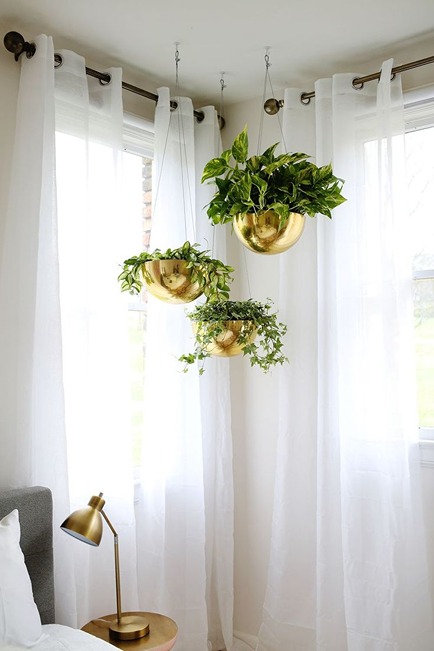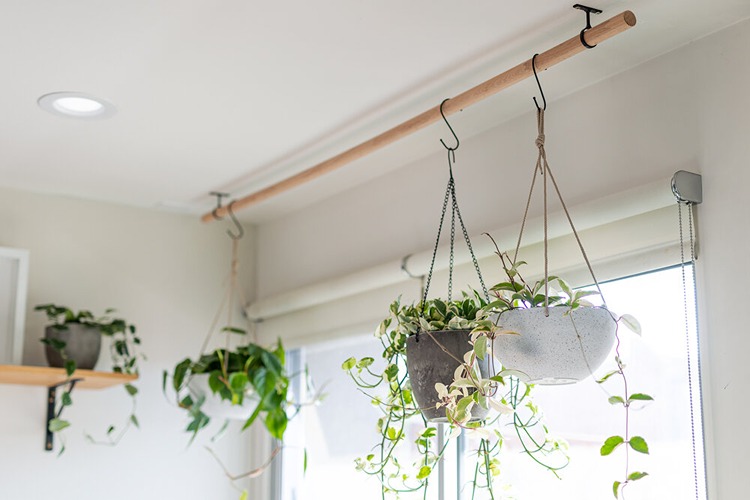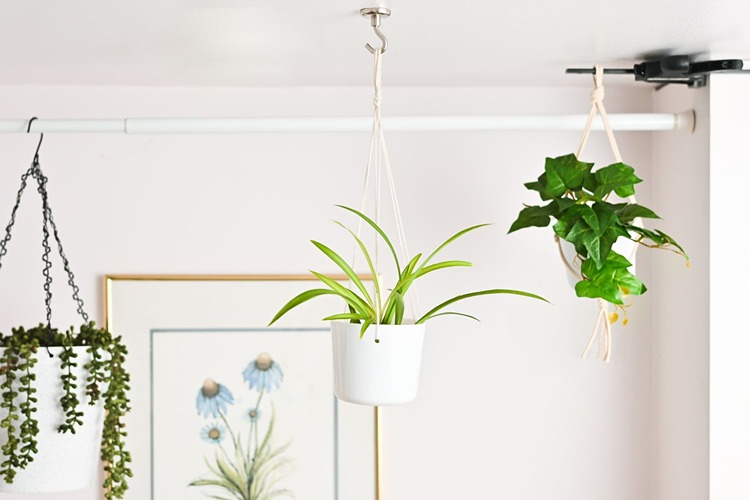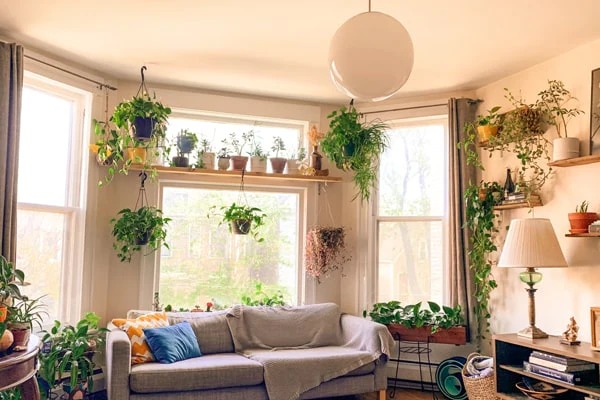Get Creative : Hang Plants from the Ceiling
Hanging plants from the ceiling adds a unique touch of greenery and visual interest to any room. Hanging plants from the ceiling can help maximize space, especially in smaller areas where floor or surface space is limited. Whether you prefer trailing vines, colorful blooms, or air-purifying foliage, the possibilities are endless when you decide to hang plants from the ceiling, allowing you to create your own indoor oasis.

The presence of a hanging plant has the remarkable ability to transform the ambiance of a room in a significant way. By introducing an element from the natural world indoors, it not only brings a touch of the outdoors but also contributes a vertical design feature that creates an illusion of increased ceiling height and a more spacious overall environment. When choosing to hang plants from the ceiling, ensure the ceiling structure is strong enough to support the weight and consider using appropriate anchors or hooks for secure installation.
Although the process of hanging a plant from the ceiling is relatively straightforward, it is crucial to consider a few important factors to avoid any potential damage to your home. However, there is no need to worry or feel overwhelmed. By utilizing a few basic tools and dedicating some spare moments of your time, this do-it-yourself task becomes easily achievable for anyone.

How to Properly Hang Plants from the Ceiling
Ensuring that you hang your plants correctly is crucial to prevent any unfortunate incidents, such as your spider plant unexpectedly falling on someone seated beneath it. This process is relatively simple and should take approximately 20 minutes to complete. Follow the steps below for a successful installation:
Step 1: Assess Your Ceiling
Begin by confirming whether your ceiling is capable of supporting a hanging plant. While most ceilings are suitable, it is advisable to avoid hanging plants from ceilings constructed with very thin paneling or tile. The material of your ceiling should possess reasonable durability.
Take note of the type of ceiling material you have, which may include:
- Drywall: This is the most common ceiling material found in homes constructed within the past 50 years. If your walls are made of drywall, it is likely that your ceiling is as well.
- Wood: A wooden ceiling typically consists of planks securely fastened to rafters. The thickness of the wood can influence its suitability for hanging plants.
- Plaster: Older homes often feature plaster ceilings applied to thin strips of wood called lathes. Plaster is a sturdy material, but caution must be exercised when drilling.
- Fiber tile: Rooms with drop ceilings often have lightweight tiles suspended from a metal framework attached to the rafters. These tiles can be delicate when it comes to hanging plants, requiring careful handling.

Step 2: Select an Appropriate Hanging Method for your Plant Hook
The choice of hanging method will depend on the material of your ceiling. Consider the following tips:
- Drywall or Plaster: To distribute the weight of the plant and prevent the hook from pulling out of the ceiling, you will need a drywall anchor or toggle bolt. These can be readily found at any hardware store.
- Wood: If the wood is thinner than approximately half an inch, employ a toggle bolt, similar to what is used with drywall. For thicker wood, a regular plant hook without additional reinforcement can be used.
For those with drop ceilings, it is important to avoid drilling holes in the tiles when hanging plants. Instead, an alternative method is required, involving the attachment of a hook to the metal frame supporting the tiles. These hooks specifically designed for drop ceilings can be purchased from hardware stores or online retailers like Amazon. They are capable of supporting approximately 15 pounds of weight, making them suitable for lighter plants. It is advisable to select plants within this weight limit to ensure proper stability and prevent any potential damage to the drop ceiling.

Step 3: Prepare the Necessary Tools
Before proceeding with hanging your plant, ensure you have all the required tools at hand. In addition to the plant itself, you will need the appropriate materials for securely suspending it. Depending on your preferred hanging method, you may choose a pot with a long hanger, a macramé plant holder, or any other specialized hanging plant container.
Next, gather the following supplies:
- Plant Hook: Select a plant hook that is adequately sized to accommodate your plant hanger comfortably and has a weight limit that matches the weight of your plant. This will ensure proper support and prevent any mishaps.
- Ceiling or Drywall Anchor: If your ceiling or wall requires additional support, you may need a ceiling or drywall anchor. This will help distribute the weight and provide stability. Determine if your specific installation requires this and obtain the appropriate anchor if necessary.
- Drill: Have a drill available for creating holes in the ceiling or wall for the anchor or hook. Ensure the drill is in good working condition before proceeding.
- Drill Bit: Choose a drill bit that is slightly smaller in diameter than the anchor or hook. This will allow for a snug fit and ensure proper attachment.
- Pencil: Keep a pencil nearby to mark the desired location for the anchor or hook. This will help ensure accuracy during the installation process.
- Measuring Tape: Have a measuring tape on hand to determine the precise positioning of the anchor or hook. Accurate measurements will help achieve the desired aesthetic and prevent any imbalance.
- Stud Finder: If you are working with a wooden ceiling or wall, a stud finder can be helpful in locating the studs for added stability. Use the stud finder to identify the appropriate areas for drilling or anchoring.

Step 4: Determine the Hanging Location and Mark it
Carefully choose the desired location for hanging your plant. If the spot aligns with a rafter or stud, you can skip the use of drywall anchors and directly drill into the wood for added stability. However, if the chosen spot does not align with a sturdy support, it is crucial to utilize drywall anchors. To identify the location of a stud, utilize a stud finder. Use a pencil to mark the exact spot where you intend to hang the plant. It is advisable to double-check the placement by holding up the plant to ensure it aligns with your vision.

Step 5: Drill a Hole for the Plant Hanger
Using a drill, create a hole precisely where you marked the hanging location. If you are using a drywall anchor, ensure you follow the instructions provided, including the recommended hole size and the proper installation of the anchor. In the case of drilling into wood, make a hole slightly smaller in diameter than the screw of the plant hook to ensure a secure fit.
Step 6: Install the Hook
With the hole prepared (and the anchor, if applicable), it is time to install the plant hook. Most plant hooks can be easily screwed into the hole by rotating them. However, if you encounter difficulty while turning the hook due to the ceiling material, you can cover it with a piece of fabric to protect it and use pliers for better grip and leverage. If you are working with a different hook design, carefully follow the specific instructions provided for that particular model.
Step 7: Hang the Plant and Appreciate the Results
With all the preparation and installation completed, it’s time to hang up your plant and admire the transformation it brings to your home. Follow these final steps:
Hang the Plant: Take your plant hanger or hanging container and place it onto the installed hook. Ensure it is securely positioned and rests comfortably on the hook.
Secure the Plant: If your hook includes a clasp or keeper feature, make sure to close it tightly to provide extra security and prevent any accidental dislodging of the plant.
Step Back and Appreciate: Take a moment to step back and admire the enhanced beauty that the hanging plant has brought to your living space. Observe how it has added a touch of nature and visual appeal, making your home more vibrant and inviting.
Remember to regularly care for and maintain your hanging plant to ensure its health and longevity. Water it appropriately, provide adequate sunlight, and be mindful of any specific care instructions for the plant species you have chosen.




